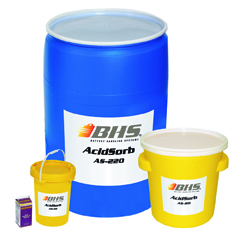We use cookies to make your experience better. To comply with the new e-Privacy directive, we need to ask for your consent to set the cookies. Learn more.
How to Prevent Battery Drips From Damaging Racks and Floors
Full-on battery spills are rare, but that doesn’t mean your racks and floors are safe. Flooded batteries tend to drip every now and then. Over time, even small volumes of escaped electrolyte can cause irreparable damage to battery racks and cement floors.
A few simple preventative measures will keep your battery room infrastructure safe from the corrosive effect of these battery drips. Just follow these tips.
● Install drip pans beneath every battery stand. Solus Group offers high-quality steel pans for both battery stands and battery stations. They’ll catch escaped electrolyte before it does any damage.
● Line drip pans with AcidSorb pillows. These absorbent pads safely neutralize acid before it reaches the metal surface below. When a pillow changes color, indicating neutralized acid, simply replace it with another. This low-cost technique provides multiple layers of protection for racks and the floors beneath them.
● Clean battery racks frequently. The corrosive effects of battery acid can start small, but if you don’t address the issue, you may find yourself shopping for entirely new racking systems. Luckily, the AcidSorb spray bottle from Solus Group makes cleaning battery racks easy. Just follow these steps to keep your racks like new:
1. Spray AcidSorb on the surfaces of your racks. If acid is present, the neutralizer will turn yellow.

2. Scrub the corroded areas with a stiff, non-sparking poly brush.
3. When the spray turns a purple color, the acid has been neutralized and it’s ready to rinse with water.
● When you clean battery cases, racks, or any surface that has been exposed to electrolyte, make sure you’re properly protected. Solus Group’s Protective Kit provides the personal protective equipment that OSHA recommends.
The sulfuric-acid-and-water mixture in your forklift batteries does a great job of powering your forklifts. But with its acidic content, electrolyte can do a lot of damage to racks and floors. Here are the two major hazards you’ll avoid by following the tips outlined above:
● Dangerous corrosion on battery system stands - While the ratio of sulfuric acid to water in electrolyte varies by battery, it’s usually around 7:13. Unfortunately for metals, water exacerbates the effects of acid, so a diluted mixture like electrolyte can actually do more damage than pure acid. The more diluted the acid, the more rapid the harmful reaction.
Metals typically found in the warehouse, including steel and other alloys, are particularly susceptible to damage by diluted sulfuric acid. At first, you may just see some minor corrosion. However, if exposure continues, the acid will begin to eat through steel.
Long-term contact with diluted sulfuric acid causes more than cosmetic damage. Given enough time, this caustic substance can cause steel to warp. This warping occurs because a byproduct of corrosion is hydrogen gas, which removes steel's protective layer of iron sulfate. The reaction between the sulfuric acid and steel yields further iron sulfate, but this "replacement" layer occurs unevenly, causing metal to warp. That’s not something you want to see in a battery stand.
●Pitted, uneven concrete flooring - When sulfuric acid touches concrete, it actually causes two types of damage. Cement paste contains a large amount of calcium hydroxide that dissolves on contact with acid.
Even worse, diluted sulfates create further damage to concrete. Water-diluted sulfates can deeply penetrate your floors and cause extensive cracking, expansion, and the loss of bond between the cement paste and the aggregate.
So, while stored forklift batteries might be out of sight, they shouldn't be out of mind. It's expensive enough to replace a battery rack that's been irreparably damaged or warped. Combine that with putting down a new floor, and you’re looking at some serious cost overruns.
Instead, rely on drip pans, AcidSorb Pillows, and regular cleaning to keep your battery room running smoothly.
References:
“Acid Attack On Concrete.” Concrete-Experts. Concrete Experts International, n.d. Web, 22 Jan. 2016.
“Forklift Trucks - Batteries.” CCOSH. Canadian Centre for Occupational Health and Safety. 2 Oct. 2013. Web. 22 Jan. 2016.
“Sulfate Attack In Concrete and Mortar.” Understanding-Cement. WHD Microanalysis Consultants Ltd., n.d. Web. 22 Jan. 2016.
“What Are the Effects of Sulfuric Acid on Metal?” wiseGeek. Conjecture Corporation, n.d. Web. 22 Jan. 2016.
“What Are the Effects of Sulfuric Acid on Steel?” wiseGeek. Conjecture Corporation, n.d. Web. 22 Jan. 2016.
